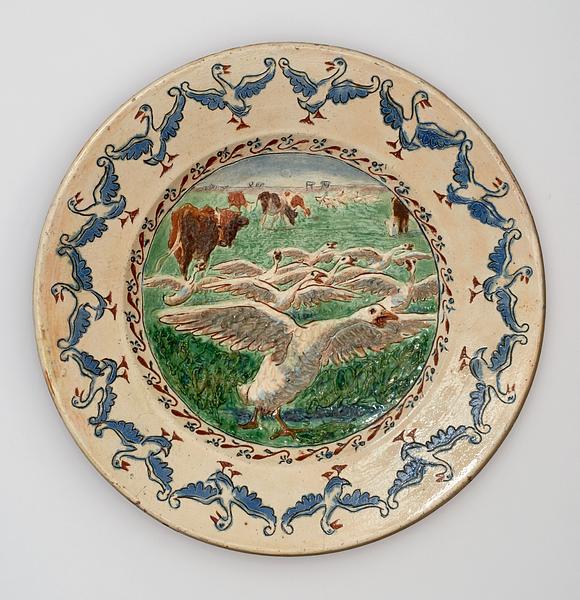Theodor Philipsen (1840–1920)
Geese Taking Flight, 1891
Glazed earthenware
Diam: 29.8 cm
In the early 1880s, alongside a number of outstanding artists, Theodor Philipsen began working at Johan Wallmann’s pottery in Utterslev Mark on the outskirts of Copenhagen. Here, the artists could work freely with clay as a material and mode of expression, receiving help from professional potters who could also provide advice on slips, glazes and firing. Many and highly diverse works were produced at the Utterslev pottery. In Philipsen’s case, the efforts focused on transferring his much-loved animal motifs from Saltholm to ceramic dishes and sculptural figures.
On this dish, Philipsen has drawn a decorative scene of flying geese using clear, incised contours. He then proceeded to use a range of different colours, clearly focusing on working with effects of light and shadow in the birds’ plumage. Philipsen also processed the clay itself by creating small, ‘brushstroke-like’ depressions in it, adding an expressive feel to the decoration. The circular shape of the dish is accentuated by a decorative framing encompassing two elements: a narrow border featuring a stylised pattern as well as a larger, charming design of standing geese with outstretched wings on the wide lip.
A similar dish belongs to The Art Museums of Skagen.
[1] The motif of flying geese also appears on another ceramic dish by Philipsen, created in 1893.
[2] However, the shape of that piece is different, as the decoration is painted all the way to the rim of the lipless dish.
Inv. no. B 395
Published in:
Erik Zahle: ”Malerisamlingens vækst” in C.L. Davids Samling, Tredie del, København 1958, p. 125;
Finn Terman Frederiksen in Kjeld von Folsach and Nana Lund (eds.): Dansk kunst i Davids Samling – fra Philipsen til Saxbo, København 1995, cat.no. 3, pp. 58-59;
Lars Dybdahl: Dansk keramik 1850-1997, Sophienholm, Lyngby 1997, cat.no. 56, pp. 19, 112;
Finn Terman Frederiksen: Theodor Philipsen. En traditionsbevidst nyskaber, Randers Kunstmuseum, Randers 2016, fig. 24, pp. 238-239, BFL 1687, p. 515;
